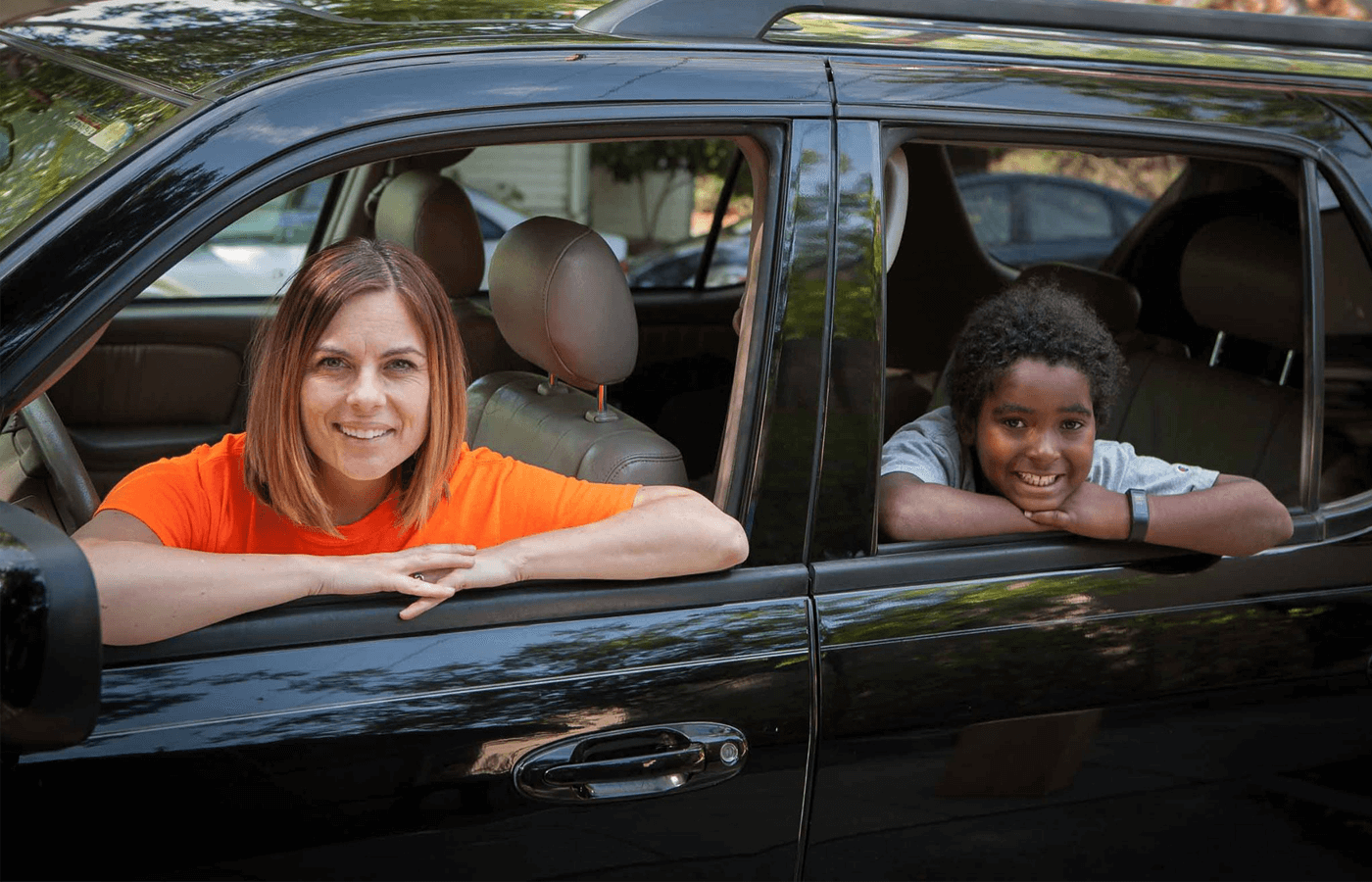
Just as there’s no one-size-fits-all way to educate students, perhaps there’s no one-size-fits-all-way to get them to school either.
That’s the argument behind HopSkipDrive, a startup that is seeking to complement and redefine the traditional bus model of taking students to school. Instead of kids making their way to the pre-determined route of a 72-passenger school bus, HopSkipDrive creates customized pick-ups in cars and vans based on individual students’ needs. It’s a rideshare-like model with similarities to and major differences from Uber and Lyft.
The company provides an app that connects families and students with highly vetted drivers, all of whom are also experienced caregivers who either currently have a child at home or have cared for children in the past. They use their personal, pre-approved cars to drive students to and from school or after-school activities, while families and the contracting agency—such as a school, welfare office, or group home—can track the car’s movement in real time. Rides are scheduled well in advance but can be changed with a few hours’ notice.
When three parents launched the app in 2015, “it had nothing to do with school transportation,” said Chief Executive Officer Joanna McFarland, a cofounder and mother of two. “It really had to do with creating options for full-time working moms and families like mine, who were really struggling to just make the logistics of running a family work.”
But safely transporting kids turned out to be a widely shared challenge. Today, Los Angeles-based HopSkipDrive contracts with schools, districts, counties, and nonprofit partners in eight states and Washington, D.C., with a focus on meeting the transportation needs of students who fall outside traditional school-bus norms.
A Widespread Problem
The initial idea for HopSkipDrive was hatched at a child’s birthday party, and the original intended market was parents like McFarland and her cofounders, who wanted to get their kids to after-school activities safely without interrupting their own workdays. But company leaders soon realized there was a broader need for more flexible student transportation options, fueled by phenomena such as open enrollment within districts, students attending out-of-neighborhood “choice” schools, the less-predictable needs of students experiencing homelessness, and varied start times within districts. Within about two years, HopSkipDrive started to work with counties and school boards that were struggling to meet transportation needs because of a growing shortage of bus drivers.
After the abrupt closure and eventual reopening of schools due to Covid-19, those shortages grew more severe. Many districts initially furloughed drivers during school-building closures, and many of those drivers did not return to the job after schools reopened. A 2021 survey by the National Association for Pupil Transportation found that every region of the country was experiencing driver shortages, and at least two-thirds of districts had altered service as a result. Some 51 percent of respondents described shortages as “desperate.”
With fewer school-bus drivers, districts have consolidated routes and lack back-up options when a driver calls out sick. Some districts in Georgia cut bus service for students attending charter schools or schools of choice. Service gaps have caused many students to arrive late or miss school if their parents and neighbors are unable to carpool on the fly. Some state and district leaders have gotten creative in their responses to the problem: Massachusetts called on National Guard troops to drive students, and Washington, D.C., launched a free school-bus driver training program for city cab drivers.
HopSkipDrive, which initially laid off much of its staff and launched an adult ride option during the pandemic, proved another ready solution—and one that had been designed by parents with children and family needs in mind.
“Caregivers on Wheels”
HopSkipDrive rides are performed by what the company calls “CareDrivers”—adults who are vetted both for their experience with children and driving abilities. CareDrivers must have five years of caregiving experience as parents, guardians, nannies, teachers or paraprofessionals, or in other childcare roles. They submit to a 15-point certification process, which includes a fingerprint-based background check, motor vehicle history search, and ongoing monitoring for new driving infractions. The driver must use a vehicle that is less than 10 years old and seats four to seven passengers. New drivers go through a live orientation with a member of the HopSkipDrive team.

The company facilitated more than 400,000 rides for children and families in 2021, with a group of more than 4,000 active CareDrivers serving about 350 school districts. Over 2 million children have been driven safely over the company’s brief history. These rides totaled more than 7 million miles in 2021, and 99.7% concluded without a safety-related issue. In all, HopSkipDrive rides have traveled more than 20 million miles to date, with no critical safety incidents.
The company keeps close watch on drivers during rides. Using telematics—the long-distance transmission of digital data—HopSkipDrive tracks the whereabouts of drivers and children. It also checks for unsafe driving behaviors by monitoring phone usage, speeding, acceleration, hard braking, and hard turning. This technology provides visibility without installing in-vehicle cameras, which pose privacy concerns. In addition, the company also provides districts and parents with backup drivers in case of a last-minute cancellation, as well as real-time location updates.
Other innovators in this space use similar driver vetting and real-time location tracking via apps, but with different focuses. For example, Zum contracts with schools and districts to modernize routes and fleets, enhance efficiency, and provide carbon-neutral transportation in cities such as Los Angeles, San Francisco, and Seattle. TaxiMom offers a subscription-based transportation service for families in the Dallas-Fort Worth and Houston markets.
Part of the Transportation Puzzle
HopSkipDrive is not looking to replace the school bus. In a densely populated area, filling a 72-passenger bus is still the most efficient way to get students to school. Facilitated ridesharing is instead one part of a more comprehensive transportation solution for school districts, two-thirds of which own their fleet of buses.
But the company does look like a disruptive innovation relative to the school bus. It is bringing a more affordable and customizable technology-based solution that isn’t as good as the status quo, judging by historical measures of performance, to non-consumers for whom the alternative is nothing at all. In this case, HopSkipDrive is using technology to reach students who previously had no district-provided ride or who were over-served by a large school bus in a lightly populated area.
For example, one of HopSkipDrive’s larger partnerships is with the Aurora Public Schools in Colorado. The district uses HopSkipDrive to provide school transportation for about 70 students who are experiencing homelessness, are in foster care, or have special needs or disabilities that make riding a school bus challenging.
“These are kids who don’t fit neatly on a school bus route or kids who are highly mobile and moving frequently,” McFarland said. “If you are a child in the foster system who moves placements at 10:30 at night, you can’t reroute a school bus to get that child to school. And yet HopSkipDrive can get them to school the next day with no change in schooling. And we know that every time a child moves—and the average child in foster care might move three to five times a year—that might mean switching schools. Credits don’t transfer. It can take several weeks to change schools. What one district teaches in fourth grade, another district teaches in fifth grade… We have federal mandates to fix that, but transportation is one of the biggest barriers. And a service like HopSkipDrive really helps districts provide transportation for those hardest-to-serve students in a really flexible way.”
At Rocky Mountain Prep, a charter school in Colorado, the arrangement works differently. There, HopSkipDrive helps specific students who are struggling to get to school, buying time for the school and families to develop longer-term solutions to the attendance challenge. In one instance, Rocky Mountain Prep provided HopSkipDrive to a parent who had recently given birth to help get her older child to school for a few weeks.
HopSkipDrive may also lead to better optimization of school transportation in the longer run, said McFarland.
“Some of our more innovative districts are really starting to think in a much more holistic way, and we are helping them really think about: ‘What does your fleet size need to look like? How many buses do you need? How many drivers do you need?’” she said. “Because we’re operating in this world of shortages, but when you think about it as a utilization problem, maybe the number of bus drivers that we have is actually sufficient. Maybe we can … save money and use that money to increase bus driver salaries and retain drivers.”
Driving into the Future
The question for any transportation innovation now is whether it can scale. Regulation will play a role.
Many states have antiquated regulations around who can drive students to schools, according to McFarland. For example, Massachusetts requires a driver to have a certification that is close to a commercial driver’s license—a rule designed for safety back when a school bus was the only transportation a district would have provided for students to get to school. Similarly, many districts require their own unique background checks for potential drivers, a roadblock for vetted CareDrivers who want to drive for multiple districts.
States are updating their laws, however, to make room for new transportation solutions. A 2021 Maryland law allows districts to transport students in vehicles other than official school buses, and new regulations in Georgia permit the use of “alternative vehicles” for students who receive special-education services, are in foster care, or are experiencing homelessness.
The ultimate solution seems to be to update transportation regulations to focus on outcomes—namely safety and reliability—instead of inputs. That means setting a baseline for safety consistent with different vehicle types and using technology to enforce safety and create accountability.
Looking beyond once-in, once-out traditional school busing will be especially important in states where educational options are proliferating, through charter schools, education savings accounts and micro-grant programs, microschools, and other flexible and innovative schooling arrangements. Today, somewhere between 1.1 and 2.1 million students are enrolled in microschools or learning pods, for example.
But these options aren’t real choices if students don’t have a way to get there.
“We see over and over again, parents would choose a particular school for their kids, but they don’t enroll in that school because it’s across town or it requires two hours on a public bus or they just can’t get their kids there,” McFarland said.
Some states aren’t just modernizing their transportation regulatory framework, they are seeking to spur innovation. The Arizona Transportation Modernization Grants Program, for example, awarded $19 million in its first year to 24 schools and nonprofit education agencies with novel transportation solutions. That included the Black Mothers Forum, a nonprofit that operates microschools in Tempe and South Phoenix, which developed a community carpool app and provided transportation for all students. And it included Tolleson Union High School District, which contracted with HopSkipDrive to create a hub-and-spoke model to provide transportation to out-of-district students that want to attend one of its specialized programs.
The models are different, but the goals are the same: Reduce the time in transit for students and get them to their educational options on-time, safely, and ready to learn.
“You might have a bus that is full in the morning but in the afternoon is empty because kids are doing different activities,” McFarland said. “So, when you start to think about that, you can open up so many opportunities both inside and outside the classroom. Just thinking a little bit more holistically and a little bit more creatively.”
Michael Horn is an executive editor of Education Next, co-founder of and a distinguished fellow at the Clayton Christensen Institute for Disruptive Innovation, and author of From Reopen to Reinvent.
This article appeared in the Summer 2023 issue of Education Next. Suggested citation format:
Horn, M.B. (2023). Beyond the Big Yellow Bus: Can transportation apps reinvent how students get to school? Education Next, 23(3), 76-79.


